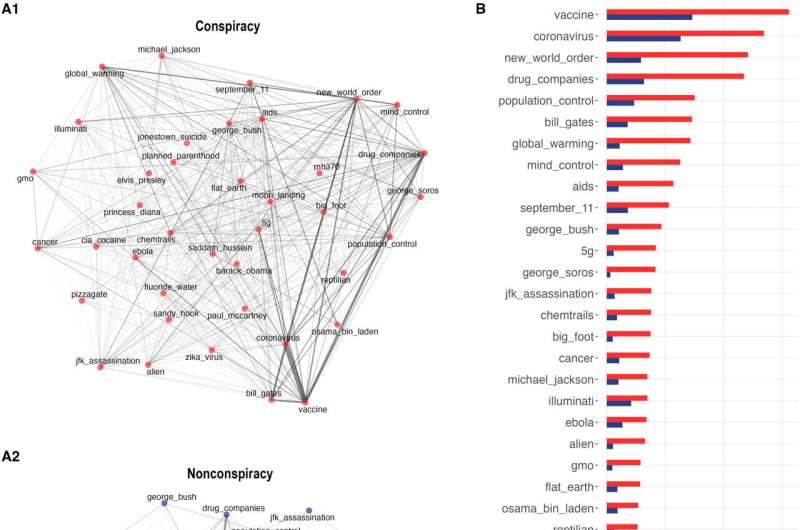The conspiracy theorist 'worldview' and the language of their argument

A study, now published in Science Advances, has analyzed the difference between mainstream and conspiracy articles. It found that conspiracies rely on other conspiracies as "evidence," jumping around different topics, less coherently than mainstream texts, but relying on a web of interconnected ideas to connect the dots.
As an example, the conspiracy theories surrounding the COVID-19 pandemic are often associated with other conspiracies, including those relating to JFK's assassination, Bill Gates and drug companies. This supports the idea of a "conspiracy worldview"—that those who are inclined to believe in a particular conspiracy will likely believe in many others and use them as evidence to support their arguments.
What's more, while conspiracy theorists encourage open debate about conspiracies—such as that Princess Diana's death was either faked or that she was killed by an insider—they tend to refute counterarguments from mainstream accounts, such as that her death was a tragic accident.
The research was led by Professor Thomas Hills, of the University of Warwick's Department of Psychology, and Alessandro Miani and Professor Adrian Bangerter at the University of Neuchatel, Switzerland.
The team analyzed thousands of conspiracist and mainstream webpages using natural language processing, a type of computer analysis of human language. They compared mainstream and conspiracist writing on the same topics.
University of Warwick Professor Thomas Hills said, "This study is groundbreaking, as it is the first to look at the language of conspiracy theories in such a large dataset, of thousands of articles. It helps identify what makes a conspiracy theory part of the conspiracy worldview.
"The implications of these findings speak to topical events such as the COVID-19 pandemic, vaccine uptake and the apparent rise of misinformation. We can see the potential disastrous consequences of a conspiracy worldview on society, such as less people taking up the COVID-19 vaccines. Conspiracy theories are on a spectrum of misinformation and to combat them, we have to understand how they work."
More information: Alessandro Miani et al, Interconnectedness and (in)coherence as a signature of conspiracy worldviews, Science Advances (2022). DOI: 10.1126/sciadv.abq3668
Journal information: Science Advances
Provided by University of Warwick





















